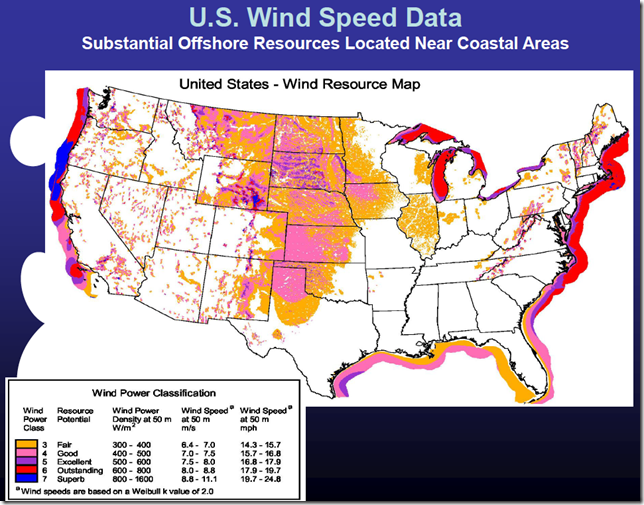Thursday, April 09, 2009
The geography of wind
In case you were wondering which places have the most potential to generate wind power, here's a nifty map of same. There are a lot of becalmed areas, one of the reasons why we need a more efficient electrical grid.
10 Comments:
By SR, at Thu Apr 09, 09:52:00 PM:
Hence, "The Pickens Plan."
http://www.pickensplan.com/theplan/
By , at Thu Apr 09, 09:55:00 PM:
is there a way to harness all that hot air blowing out of DC?
By , at Thu Apr 09, 10:03:00 PM:
Take a look at western border of Illinois, along the Mississippi River. Then look at the eastern border of Illinois. No potential in Kentucky or Missouri? Hmm, the Wisconsin border seems to cause the same kind of quirky wind behavior. Kind of strange the wind potential starts and stops on a dime all around the state. Sure makes me question any data displayed on this map.
By Who Struck John, at Thu Apr 09, 10:17:00 PM:
Keep in mind also that there is a limit to how much wind energy the grid can deal with, so long as we do not have industrial-scale efficient energy storage. The data from Denmark (which has tried this) is that the grid has stability problems when wind power use approaches 20% of the grid capacity. You do not want to have a grid with brownouts and voltage spikes.
By Who Struck John, at Thu Apr 09, 10:23:00 PM:
Note also, the way grids balance load is to use peaker plants or hydropower to smooth out the power generation. Hydropower is pretty much fully exploited; no help there. Peaker plants are typically gas turbine units burning natural gas. So Picken's plan puts more windpower on the grid, causing a need for more peaker plants, not fewer, to balance the load. He then advocates putting our transportation infrastructure on natural gas fuel. The result is increased natural gas demand both for electricity generation AND transportation.
The Pickens plan is really the Pickens plan for picken' money out of your wallet.
By , at Fri Apr 10, 08:26:00 AM:
Gee whiz, that area along the southern shore of Cape Cod looks like one of the few "superb" spots on the east coast. Those advocating publicly in favor of extensive wind power probably think that would be an outstanding place to build!
By SR, at Fri Apr 10, 09:21:00 AM:
WSJ is right about Pickens wanting to pick pockets, but
if Obama gets the government to own stock, Pickens can be summarily fired.
By , at Fri Apr 10, 10:36:00 AM:
From Link:
I learned something on this site some months back -- when JFK famously said we'd go to the moon in a decade, it wasn't the proverbial moon shot. Grumman and others had worked out the plan -- when JFK spoke in 1961 there was no need for scientific breakthroughs -- it just required engineering execution. You could budget a timeline to an expected result.
On energy, Obama is no JFK. He wants us to try a moon shot that we should know won't work.
Wind can never be more than 10% of the mix. Solar isn't cost effective for large scale generation and may never be ... we still need scientific breakthroughs. Obama wants to restrict domestic oil production and is cutting off new nuclear in subtle ways. Cap and trade will disrupt the economics of the entire industry.
Years ago, I heard Neil Young rant that we could grow all the ethanol we needed to run our cars -- and that it was the big oil companies that were stopping it from happening. You wouldn't want to hear me sing.
By Nobrainer, at Fri Apr 10, 12:40:00 PM:
There are many ways to interpret "a more efficient electrical grid." If we focus on the efficiency of the transmission system, then connecting the major load centers to wind farms in the middle of nowhere will actually make the transmission system much less efficient due to the significantly longer distances the power has to travel.
By GreenmanTim, at Fri Apr 10, 03:45:00 PM:
Some elements within the conservation community have been working with others in the wind industry to trying to develop siting criteria for wind power that they all can get behind.
The idea is to take data such as this purports to be and intersect those areas with great wind generating potential with areas of high ecological value and see what remains where wind power development should be encouraged.
The Appalacian Mountain Club, The Nature Conservancy, and the Delaware Chapter of the National Audubon Society have all made efforts in this direction.
AMC's involvement is particularly interesting, because unlike the other two organizations it has a scenic and aethetic mandate as well as an ecological one.
My 2 cents are that it is often difficult for conservationists to make the trade off between local impacts and regional benefits, and having criteria like these is likely to make it easier to support decisions where trade offs are needed.




